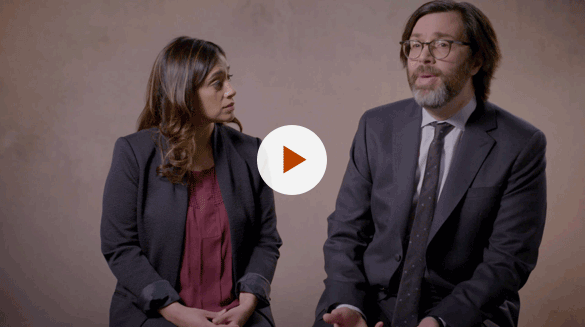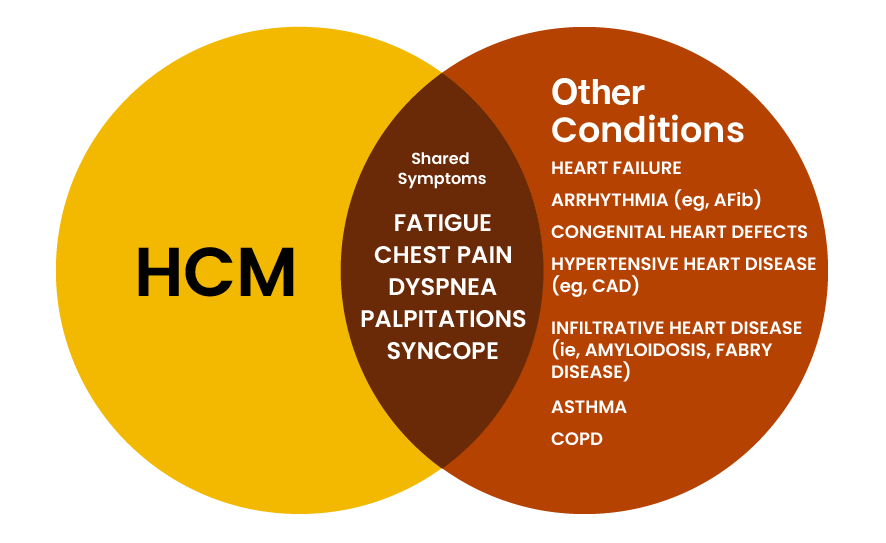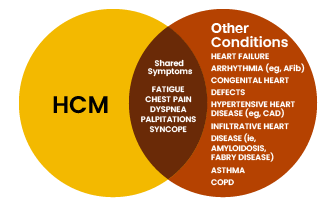 This website is best viewed
This website is best viewed
using the horizontal display
on your tablet device.
Go to Patient Website

Understanding Hypertrophic
Cardiomyopathy
Background
HCM is a chronic cardiovascular disease, and its progressive nature can potentially lead to debilitating symptoms and serious complications1
HCM is caused by dysfunction in the cardiac sarcomere that causes excess myosin-actin cross-bridging, which leads to increased contractility, impaired relaxation, and increased energy consumption.2
In HCM, there is a thickening, or hypertrophy, of the left ventricular wall that cannot be explained by another cardiac, systemic, or metabolic disease.3
HCM has a diverse phenotypic presentation and can occur in 2 different forms, both of which can lead to adverse complications and outcomes.4,5 Most patients with HCM experience left ventricle outflow tract obstruction (LVOT) obstruction either at rest or under provocation.1
Obstructive hypertrophic cardiomyopathy
(oHCM)

obstructive hypertrophic cardiomyopathy (HCM)
Nonobstructive hypertrophic cardiomyopathy (nHCM)
Obstructive hypertrophic cardiomyopathy (oHCM)
oHCM occurs when thickening of the ventricular
septum causes a dynamic narrowing that can
block or reduce blood flow from the LV to the aorta.
LV outflow tract (LVOT) obstruction is an important
component of this form of the disease and may
involve the mitral valve.7
SAM=systolic anterior motion.
Nonobstructive hypertrophic cardiomyopathy
(nHCM)

obstructive hypertrophic cardiomyopathy (HCM)
nonobstructive hypertrophic cardiomyopathy (HCM)
Nonobstructive hypertrophic cardiomyopathy (nHCM)
In nHCM, cardiac wall thickening occurs without
restricting blood flow.5

Prevalence
HCM is the most common heritable heart disease, yet relatively few patients may be aware they have it6
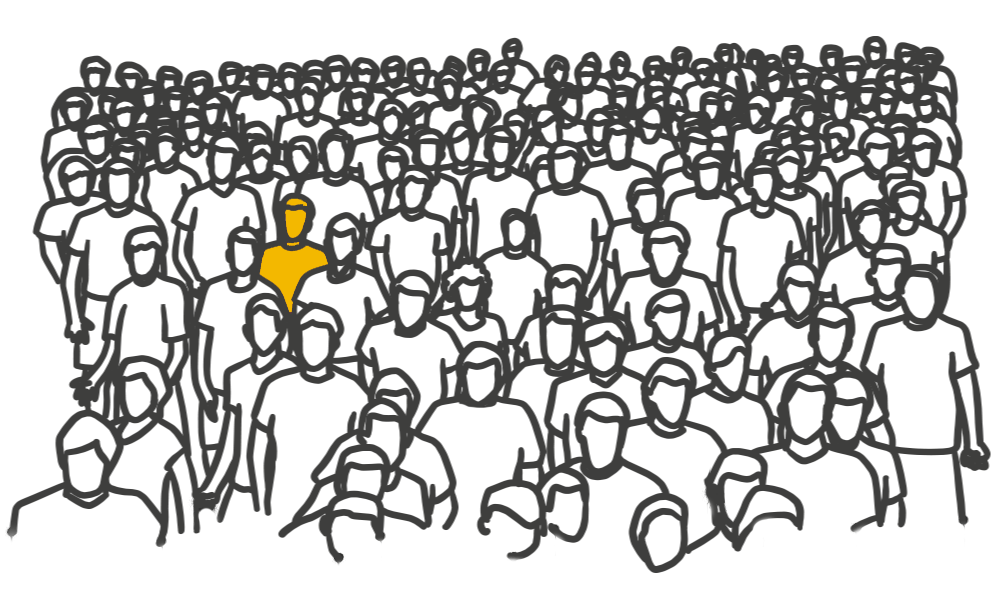
The reported prevalence of HCM ranges from
1 in 200 to
1 in 500
people in the general population.3,7,8*†
*
The CARDIA study (published in 1995) was a multicenter, US-population-based echocardiography study of 4111 subjects (aged 23-35) that identified the prevalence of HCM as 1:500 people in the general population.7
†
The 2015 Semsarian publication identified that the prevalence of HCM gene carriers could be as high as 1:200.8
It has been estimated that ~700,000 people in the US have HCM, yet
~85%
of them may remain undiagnosed.9‡
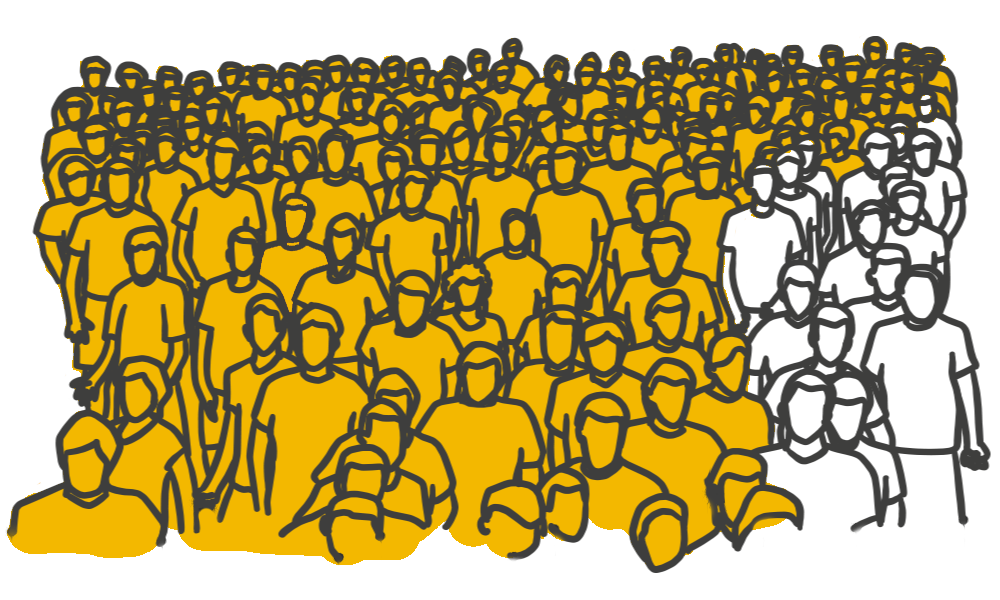
‡
Based on a 2013 ICD-9 claims database analysis (N=169,089,614) that estimated/concluded: 1. ~600,000 patients with undiagnosed HCM (based on analysis’ assumption that 1 in 500 prevalence represents clinically unrecognized cases), 2. ~100,000 patients with diagnosed HCM (based on 2013 US Census population and the ratio of 59,009 patients with a claim for HCM over the total N, stratified by age/gender), and 3. ~700,000 overall US prevalence of HCM.9
HCM can be genetically passed down from one generation to the next in some patients.3 HCM frequently remains undiagnosed until young adulthood and even as late as midlife, allowing disease progression to go unmitigated.10

Patient Impact
Complications of HCM can include heart failure, atrial fibrillation
(AFib), stroke, and rarely, sudden cardiac death1
Stroke is a complication of HCM and is even more
common in HCM with accompanying AFib.11
Based on a community-based population of 480 patients with HCM:
Patients with
HCM
were up to
6x
more likely to
develop AFib11§
Ischemic
strokes were
8x
more frequent in
patients with AFib11
§
Based on the study AFib prevalence of 22% (107/480) and incidence of 2% new cases annually.11

22%
to

43%
of patients with HCM
developed heart failure12,13II
||
A retrospective analysis of 4591 patients with HCM (63% male; median age at diagnosis: 45.8 years; median follow-up: 2.9 years) from the SHaRe Registry found a prevalence of 22%. A prospective, single-center observational study of ~1000 consecutive patients with HCM (63% male; age at diagnosis [years ±SD: 43±18]; median follow-up: 6.6 years) found a prevalence of 43%.12,13
SD=standard deviation.
Based on international registry data
from 1960-2016 (N=4591)
All-cause mortality risk was substantially higher in
both younger and older patients with HCM than that of
the general population at US sites13¶:
>4
fold higher for
patients ages
20-29
 3
3
fold higher
for
patients ages
50-69
Sudden cardiac death (SCD) is uncommon, occurring in ~1% of patients with HCM13
¶Mortality rates for the general US population were based on 1999 to 2014 data from the Centers for Disease Control and Prevention WONDER database.13
HCM can impact patients physically, emotionally, and psychologically14
Lifestyle changes can negatively impact the psychological and emotional health of patients, as can decreased physical function and anxiety about future medical complications.14
The full impact of HCM on patients can sometimes be hidden, as patients tend to adapt their lifestyles to accommodate their limitations as their symptoms gradually progress.15,16

Signs & Symptoms
REFERENCES:
Naidu SS, ed. Hypertrophic Cardiomyopathy. London, Eng: Springer-Verlag; 2015.
Garfinkel AC, Seidman JG, Seidman CE. Genetic pathogenesis of hypertrophic and dilated cardiomyopathy. Heart Fail Clin. 2018;14(2):139-146.
Ommen SR, Mital S, Burke MA, et al. 2020 AHA/ACC guideline for the diagnosis and treatment of patients with hypertrophic cardiomyopathy: a report of the American College of Cardiology/American Heart Association Joint Committee on Clinical Practice Guidelines. Circulation. 2020;142(25):e533-e631.
Rowin EJ, Maron MS. The role of cardiac MRI in the diagnosis and risk stratification of hypertrophic cardiomyopathy. Arrhythm Electrophysiol Rev. 2016;5(3):197-202.
Stanford Health Care. Hypertrophic cardiomyopathy. Accessed June 14, 2021. https://stanfordhealthcare.org/medical-conditions/blood-heart-circulation/hypertrophic-cardiomyopathy.html
Maron BJ, Rowin EJ, Maron MS. Global burden of hypertrophic cardiomyopathy. JACC Heart Fail. 2018;6(5):376-378.
Maron BJ, Gardin JM, Flack JM, Gidding SS, Kurosaki TT, Bild DE. Prevalence of hypertrophic cardiomyopathy in a general population of young adults. Echocardiographic analysis of 4111 subjects in the CARDIA study. Circulation. 1995;92(4):785-789.
Semsarian C, Ingles J, Maron MS, Maron BJ. New perspectives on the prevalence of hypertrophic cardiomyopathy. J Am Coll Cardiol. 2015;65(12):1249-1254.
Maron MS, Hellawell JL, Lucove JC, Farzaneh-Far R, Olivotto I. Occurrence of clinically diagnosed hypertrophic cardiomyopathy in the United States. Am J Cardiol. 2016;117(10):1651-1654.
Jacobs C. Hypertrophic cardiomyopathy in adults: an overview. J Am Assoc Nurse Pract. 2014;26(9):465-470.
Olivotto I, Cecchi F, Casey SA, Dolara A, Traverse JH, Maron BJ. Impact of atrial fibrillation on the clinical course of hypertrophic cardiomyopathy. Circulation. 2001;104(21):2517-2524.
Rowin EJ, Maron MS, Chan RH, et al. Interaction of adverse disease related pathways in hypertrophic cardiomyopathy. Am J Cardiol. 2017;120(12):2256-2264.
Ho CY, Day SM, Ashley EA, et al; SHaRe Investigators. Genotype and lifetime burden of disease in hypertrophic cardiomyopathy: insights from the Sarcomeric Human Cardiomyopathy Registry (SHaRe). Circulation. 2018;138(14):1387-1398.
Zaiser E, Sehnert AJ, Duenas A, Saberi S, Brookes E, Reaney M. Patient experiences with hypertrophic cardiomyopathy: a conceptual model of symptoms and impacts on quality of life. J Patient Rep Outcomes. 2020;4(1):102.
Mayo Clinic. Hypertrophic cardiomyopathy. June 2, 2020. Accessed April 28, 2021. https://www.mayoclinic.org/diseases-conditions/hypertrophic-cardiomyopathy/symptoms-causes/syc-20350198
Jacoby DL, DePasquale EC, McKenna WJ. Hypertrophic cardiomyopathy: diagnosis, risk stratification and treatment. CMAJ. 2013;185(2):127-134.
Marian AJ, Braunwald E. Hypertrophic cardiomyopathy: genetics, pathogenesis, clinical manifestations, diagnosis, and therapy. Circ Res. 2017;121(7):749-770.
Wexler RK, Elton T, Pleister A, Feldman D. Cardiomyopathy: an overview. Am Fam Physician. 2009;79(9):778-784.
Argulian E, Sherrid MV, Messerli FH. Misconceptions and facts about hypertrophic cardiomyopathy. Am J Med. 2016;129(2):148-152.
Fifer MA, Vlahakes GJ. Management of symptoms in hypertrophic cardiomyopathy. Circulation. 2008;117(3):429-439.
University of Maryland Medical Center. Hypertrophic cardiomyopathy types, symptoms and causes. Accessed June 14, 2021. https://www.umms.org/ummc/health-services/heart-vascular/services/hypertrophic-cardiomyopathy/types-symptoms-causes

Back To Top
 This website is best viewed
This website is best viewed
using the vertical display
on your mobile device.


